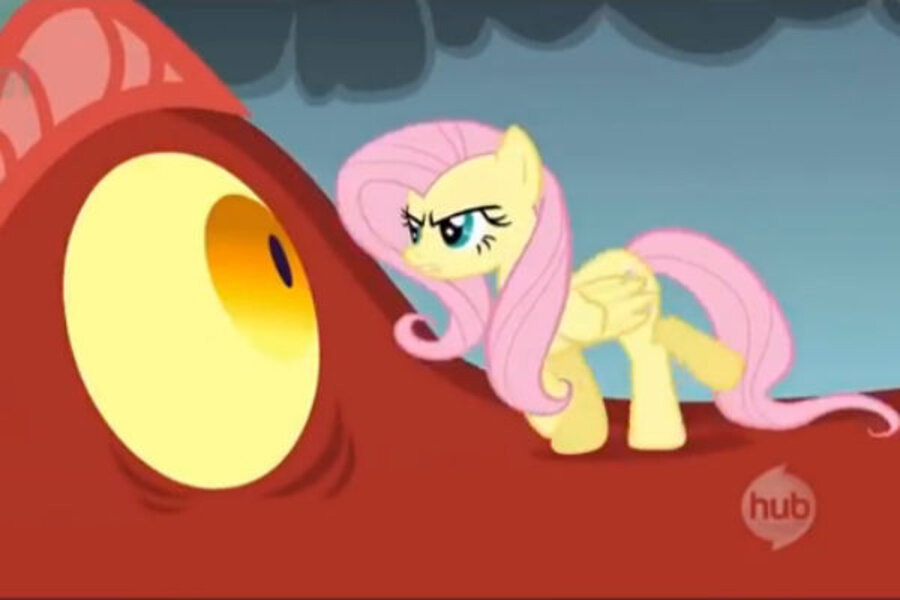Where do bullies come from? Questions raised by 'Brony' battles
Loading...
The story of Grayson Bruce, age 9, being bullied for liking the cartoon “My Little Pony” made headlines, and drew attention to the missteps taken by his school. Now, let’s take a look at the “nerd” and “hipster” cultures behind the rainbow culture phenomenon.
Grayson’s mom Noreen Bruce says the principal of Grayson’s elementary school told her the solution was for her son to leave his “My Little Pony” backpack at home, based on the theory that, by wearing it, he was advertising his passion for a show marketed to girls and creating a “trigger for bullying.”
The decision triggered international outrage, and now – hopefully – some reasonable discussion about how a show about friendly ponies could possibly become such a cultural firestorm.
“I think there’s a complete misunderstanding of the fandom of ‘My Little Pony,’ ” says Mike Bernstein, the creator of Everfree.net, a popular website for "Bronies" (the term used to define boys and men who like "My Little Pony." “Nerd culture is becoming more accepted. This is part of the bigger trend in society.”
Mr. Bernstein's website hosts 15 live radio and video shows a week for fans ages 15 to 25.
To see how that fandom translated into dollars, I called Hasbro this morning and was sent an e-mail statement telling me that the “My Little Pony” blueprint, including TV, movies, toys, and wearable items “represents approximately $650 million dollars at retail,” since the brand re-launched in 2010.
That figure doesn’t include sales catering specifically to Bronies by other licensed retailers, such as brony.com, which caters to an estimated 2 million Brony customers with spin-off products such as T-shirts, according to Bernstein.
“The My Little Pony brand and the My Little Pony Friendship is Magic series has always been about friendship, acceptance and inclusion,” a spokesperson for Hasbro wrote in an e-mail about the bullying happening to some fans. “Our pony characters and socially relevant friendship messages in our storytelling have resonated globally because our core cast of ponies all have uniquely defined characteristics and personalities that fans of all ages can relate to. We believe everyone should be treated equally regardless of how they choose to express themselves.”
When it comes to the bullying of Grayson, Bernstein says he’s reaching out to Grayson’s mom, “in the hopes of letting them know that there are lots of fans out there and that the bullying pretty much stops when you get into high school, where it’s considered a novelty and cool.”
However, after my son Quin, 10, spent all last year being bullied over telling a girl that he liked the character Rainbow Dash from "My Little Pony," I can say with authority that high school is too far off for kids like Grayson and Quin to pin their hopes on.
That’s why I’m looking into this cultural miasma today, and hoping to get haters over the issue.
We need to put the elephant in the room out to pasture by saying, not everything involving a rainbow is automatically a statement of sexual orientation.
“It’s just such an easy cultural stereotype to make,” Bernstein says. “The cheap logic jump is that any show marketed to girls is ‘feminine.’ A ‘feminine show’ which interests male viewers [can cause] leaps in logic to ‘boys who like feminine shows are effeminate.’ It’s absurd.”
To dismantle the stereotypes behind My Little Pony fans, I reviewed a study conducted by psychology professors at the University of South Carolina Upstate in Spartanburg, S.C., led by Dr. Patrick Edwards.
The 2013 study of 2,500 My Little Pony fans revealed that 32 percent were openly social about liking the show, while 18 percent preferred to hide their fandom. Of those surveyed 30 percent were a mixture, sometimes hiding their liking for the show and sometimes choosing to reveal their preferences depending on the social setting.
I also e-mailed Common Sense Media’s parenting content editor Caroline Knorr for her views on what’s happening, because her group offers tips on non-gender stereotype shows for kids.
“Many kids go through a phase of really loving certain media characters – whether or not they are considered ‘gender appropriate,’ ” Ms. Knorr says in her e-mail back. “Helping the school community to understand that would help the kid instead of making him feel guilty or like he has to ‘sneak’ what he likes.”
Knorr also suggested that schools might consider creating a social time. “What a lot of schools do in that case," she says, "is designate a particular media time like a Friday afternoon after the work is all done when kids can show and tell what they like without judgment.”
The Brony study findings seem to support Knorr’s suggestion, with the conclusion that positive reactions to the "My Little Pony" fandom are influenced by the more a person knows about the show, via pre-exposure and through the use humor in more positive (pro-social) way.
After going through a year of sadness and frustration watching my own son be bullied for liking a blue pony with a rainbow mane, I am eager to find a path to resolution.
Grayson’s mom and I have been chatting back and forth on Facebook and she tells me his favorite pony is Fluttershy.
I can see the appeal, since one of the videos I found on "My Little Pony" is one in which the painfully shy, soft-spoken, pink pony sees a massive dragon attacking her pals. Fluttershy stands up to the bully.
However, when she sees the bully meltdown, the pony soothes the bully saying, “There, there. No need to cry. You’re not a bad dragon. You just made a bad decision.”
We need to stop horsing-around and help kids make better decisions by broadening their horizons and teaching them to be part of the solution by helping dismiss invalid stereotypes.






